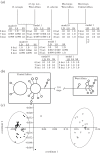Rigorous approaches to species delimitation have significant implications for African crocodilian systematics and conservation
- PMID: 24335982
- PMCID: PMC3871313
- DOI: 10.1098/rspb.2013.2483
Rigorous approaches to species delimitation have significant implications for African crocodilian systematics and conservation
Abstract
Accurate species delimitation is a central assumption of biology that, in groups such as the Crocodylia, is often hindered by highly conserved morphology and frequent introgression. In Africa, crocodilian systematics has been hampered by complex regional biogeography and confounded taxonomic history. We used rigorous molecular and morphological species delimitation methods to test the hypothesis that the slender-snouted crocodile (Mecistops cataphractus) is composed of multiple species corresponding to the Congolian and Guinean biogeographic zones. Speciation probability was assessed by using 11 mitochondrial and nuclear genes, and cranial morphology for over 100 specimens, representing the full geographical extent of the species distribution. Molecular Bayesian and phylogenetic species delimitation showed unanimous support for two Mecistops species isolated to the Upper Guinean and Congo (including Lower Guinean) biomes that were supported by 13 cranial characters capable of unambiguously diagnosing each species. Fossil-calibrated phylogenetic reconstruction estimated that the species split ± 6.5-7.5 Ma, which is congruent with intraspecies divergence within the sympatric crocodile genus Osteolaemus and the formation of the Cameroon Volcanic Line. Our results underscore the necessity of comprehensive phylogeographic analyses within currently recognized taxa to detect cryptic species within the Crocodylia. We recommend that the community of crocodilian researchers reconsider the conceptualization of crocodilian species especially in the light of the conservation ramifications for this economically and ecologically important group.
Keywords: African biogeography; Mecistops; Osteolaemus; phylogeography; speciation probability.
Figures




Similar articles
-
Species-level diversification of African dwarf crocodiles (Genus Osteolaemus): a geographic and phylogenetic perspective.Mol Phylogenet Evol. 2009 Mar;50(3):496-506. doi: 10.1016/j.ympev.2008.11.009. Epub 2008 Nov 21. Mol Phylogenet Evol. 2009. PMID: 19056500
-
Are crocodiles really monophyletic?--Evidence for subdivisions from sequence and morphological data.Mol Phylogenet Evol. 2006 Apr;39(1):16-32. doi: 10.1016/j.ympev.2006.01.012. Epub 2006 Feb 21. Mol Phylogenet Evol. 2006. PMID: 16495085
-
Did Late Pleistocene climate change result in parallel genetic structure and demographic bottlenecks in sympatric Central African crocodiles, Mecistops and Osteolaemus?Mol Ecol. 2017 Nov;26(22):6463-6477. doi: 10.1111/mec.14378. Epub 2017 Nov 1. Mol Ecol. 2017. PMID: 29024142
-
Phylogeny, phylogeography, phylobetadiversity and the molecular analysis of biological communities.Philos Trans R Soc Lond B Biol Sci. 2011 Aug 27;366(1576):2391-402. doi: 10.1098/rstb.2011.0057. Philos Trans R Soc Lond B Biol Sci. 2011. PMID: 21768154 Free PMC article. Review.
-
Is population subdivision different from speciation? From phylogeography to species delimitation.Ecol Evol. 2020 Jun 28;10(14):6890-6896. doi: 10.1002/ece3.6524. eCollection 2020 Jul. Ecol Evol. 2020. PMID: 32760499 Free PMC article. Review.
Cited by
-
Fine scale patterns of genetic partitioning in the rediscovered African crocodile, Crocodylus suchus (Saint-Hilaire 1807).PeerJ. 2016 Apr 12;4:e1901. doi: 10.7717/peerj.1901. eCollection 2016. PeerJ. 2016. PMID: 27114867 Free PMC article.
-
Environmental DNA-based biomonitoring of Cuban Crocodylus and their accompanying vertebrate fauna from Zapata Swamp, Cuba.Sci Rep. 2023 Nov 22;13(1):20438. doi: 10.1038/s41598-023-47675-8. Sci Rep. 2023. PMID: 37993480 Free PMC article.
-
Pseudosuchian thermometabolism: A review of the past two decades.Anat Rec (Hoboken). 2025 Feb;308(2):315-341. doi: 10.1002/ar.25609. Epub 2024 Dec 16. Anat Rec (Hoboken). 2025. PMID: 39682064 Free PMC article. Review.
-
Central African dwarf crocodiles found in syntopy are comparably divergent to South American dwarf caimans.Biol Lett. 2024 May;20(5):20230448. doi: 10.1098/rsbl.2023.0448. Epub 2024 May 8. Biol Lett. 2024. PMID: 38716586 Free PMC article.
-
Phylogeography, genetic diversity, and population structure of Nile crocodile populations at the fringes of the southern African distribution.PLoS One. 2019 Dec 23;14(12):e0226505. doi: 10.1371/journal.pone.0226505. eCollection 2019. PLoS One. 2019. PMID: 31869351 Free PMC article.
References
-
- Wheeler QD, Meier R. 2000. Species concepts and phylogenetic theory: a debate. New York, NY: Columbia University Press
-
- de Queiroz K. 2007. Species concepts and species delimitation. Syst. Biol. 56, 879–886 (doi:10.1080/10635150701701083) - DOI - PubMed
-
- Simpson GG. 1951. The species concept. Evolution 5, 285–298 (doi:10.2307/2405675) - DOI
-
- Wiley EO. 1978. The evolutionary species concept reconsidered. Syst. Zool. 27, 17–26 (doi:10.2307/2412809) - DOI
-
- Agapow P-M, Bininda-Emonds ORP, Crandall KA, Gittleman JL, Mace GM, Marshall JC, Purvis A. 2004. The impact of species concept on biodiversity studies. Q. Rev. Biol. 79, 161–179 (doi:10.1086/383542) - DOI - PubMed
Publication types
MeSH terms
Substances
LinkOut - more resources
Full Text Sources
Other Literature Sources

